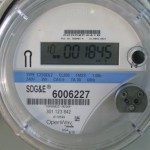
Sleeping warm
If you are on-board with the sentiment that we should strive to reduce the amount of energy we consume as a means to relieve pressure on a world suffering impending energy scarcity, then you probably want to know how one might proceed. In this post, I will describe the single-biggest energy-saving strategy I have employed in my home in the past five years, which slashed my natural gas consumption by almost a factor of five.
Last week, I described how to read gas meters, in the process discovering how onerous pilots lights can be. As a result of initial exploration of my energy footprint in the spring of 2007, I shut off the furnace pilot light for the summer, which I figured accounted for two-thirds of my warm-season natural gas use. When winter came, my wife and I challenged ourselves to hold off on re-igniting the pilot light until it got too cold for us to bear. That day never came. The result was a dramatic reduction in natural gas use.
In this post, I will talk about some of the ups and downs of adjusting to a colder house in the winter. Granted, we live in moderate San Diego, and could not get away with the same tactic in many locales. Even so, I will quantify the gains one might expect elsewhere for similar living conditions.
Continue reading →
Views: 17822
 Two weeks ago, I described my factor-of-five reduction of natural gas usage at home, mostly stemming from a decision not to heat our San Diego house. We have made similar cuts to our use of utility electricity, using one-tenth the amount that comparable San Diego homes typically consume. In this post, I will reveal how we pulled this off…with plots. Some changes are simple; some require behavioral changes; some might be viewed as outright trickery.
Two weeks ago, I described my factor-of-five reduction of natural gas usage at home, mostly stemming from a decision not to heat our San Diego house. We have made similar cuts to our use of utility electricity, using one-tenth the amount that comparable San Diego homes typically consume. In this post, I will reveal how we pulled this off…with plots. Some changes are simple; some require behavioral changes; some might be viewed as outright trickery.


